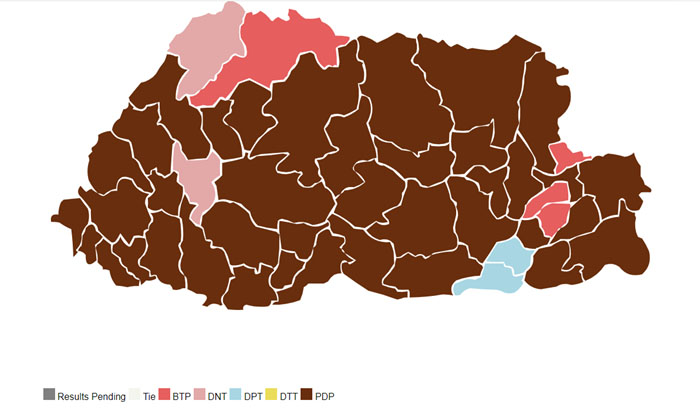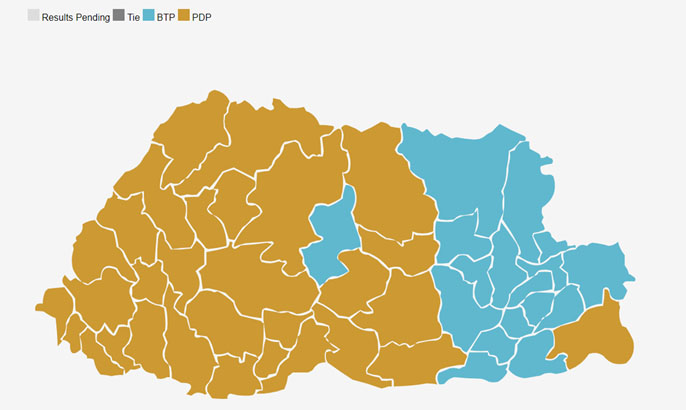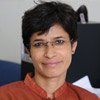You are here
Bhutan Election Paves Way for Political Transition
Summary
The Tsering Tobgay-led People’s Democratic Party (PDP) won the maximum number of seats in the Bhutan elections and formed the government. Given rising youth unemployment and domestic debt, economic issues dominated the manifestos of the political parties. As Bhutan prioritises economic development, India can be a close partner.
Bhutan, a new entrant to the democracy club, witnessed its fourth elections when the country voted on 9 January 2024 to choose a party that will govern them for the next five years. The election to Bhutan’s National Assembly saw the Tsering Tobgay-led People’s Democratic Party (PDP) winning 30 seats. Tobgay sworn in as Prime Minister of Bhutan for the second time on 28 January. He was in power from 2013 to 2018. Bhutan Tendrel Party (BTP) founded by Pema Chewang, a civil servant who had resigned from his position to join politics, is a new entrant to politics. The party won 17 seats mostly from the Eastern Part of Bhutan in the final round of the election. Bhutan has two rounds of election, the primary round which is multiparty and the final round where the contest is between the two political parties that receive the first and second highest votes.
The primary round of this election was held in November 2023 in which four political parties participated. All the political parties in Bhutan need to confirm to Section 136 of the Election Act of the Kingdom of Bhutan 2008, which requires the parties to repose faith and allegiance on the constitution, possess a broad support base irrespective of gender, religion and caste with a cross-national membership and which ‘does not receive money or any assistance from foreign sources’ be it private or government.1 Elections in Bhutan are funded by the government unlike other countries of South Asia.
Economic Concerns Dominate Elections
Economic issues dominated the electoral landscape with each political party pledging development and economic growth in their electoral manifesto. Youth unemployment in Bhutan has increased. In the post COVID-19 environment, the situation has worsened as tourism industry which employees around 50,000 Bhutanese, has been hampered. In August 2023, Bhutan cut its Sustainable Development Fee by 50 per cent to increase tourist footfall.2 According to UNDP, youth unemployment which was 11.9 per cent in 2019 grew to 22.6 per cent in 2020.3
The second main concern relates to the growing domestic debt. Currently, Bhutan has a debt to GDP ratio of 129.1 per cent. As of 31 December 2023, public debt stood at 103.2 per cent of the FY 2023–24 GDP estimate. Of the total external debt, government debt stood at 90.9 per cent which constitutes borrowings for budgetary activities, hydropower projects, and loans, with hydropower debt standing at 66.3 per cent. Yet, hydropower is also the main source of Bhutan’s export earnings.4 Migration of youth is another major challenge. According to an estimate, around 2 per cent of Bhutan’s population has migrated overseas in the last six years.5
Key Highlights of Manifestos
In Bhutan, the election manifestos of the political parties are approved by the Election Commission of Bhutan (ECB) which looks into the promises made by the political parties and the practicality of these promises. This ensures that no political party can make promises that sways the voting and yet finds it difficult to implement. The ECB appoints independent anonymous committee that holds a month-long review of the manifestos. All the political parties are required to file their election expenses to the Public Election Fund Division of the ECB. This provides a fair chance to all political parties to campaign equally. The following section provides key highlights of the election manifesto of the major political parties.
Five political parties participated in the first round of the election, while the Bhutan Kuen-Nyam Party (BKP) deregistered itself as a political party in January 2023. Voter turnout in the primary round was 63 per cent as per the data published by the ECB.6 Bhutan has a bicameral legislature—National Assembly and National Council. The apolitical National Council has 20 elected members from dzongkhags (districts) and five members are nominated by the King. The election to the National Council took place in April 2023.
Given Bhutan’s tourism potential, all the political parties promised to revisit the Sustainable Development Fund (SDF) levy on the tourists. PDP manifesto provided a roadmap to boost tourism that can employ Bhutanese and generate income. All the political parties pledged to be guided by the vision of His Majesty the King, Jigme Khesar Namgyel Wangchuck. Economic development was the focus of the election manifestos of the five political parties.
Druk Phuensum Tshogpa’s (DPT) election manifesto7 revolved around ‘Economic Prosperity and Social Well-Being’. In the context of Gross National Happiness, DPT promised high economic growth, attracting FDI and adopting a national export strategy. The manifesto prioritised Bhutan’s potential as an exporter of hydroelectricity. It promised three new hydro projects with India and also wanted to accelerate trilateral cooperation with India for export of hydropower to Bangladesh which has pledged US$ 1 billion investment in Bhutan’s 1,024 MW Dorjilung hydroelectricity project.8 India’s Guidelines for Cross Border Power Trade were announced in 2019.
The PDP manifesto9 spoke of declining birth rate and migration of Bhutanese to other countries that may impinge on Bhutan’s survival and sovereignty. The manifesto also spoke of youth unemployment with a slogan ‘For a Better Druk Yul. The Promise We Will Deliver’. The manifesto mentioned the party’s promise to develop six megaprojects and seven mini hydroprojects. Emphasing on economic revival, PDP promised to introduce ‘Buy Bhutanese Product’, introducing job protection plan in private sector, enabling private sector growth, developing infrastructure for better communication, take steps to enhance ease of doing business and attract FDI.
A new party, Druk Thuendrel Tshogpa (DTT) was registered with the election Commission in 2023. In its manifesto,10 it emphasised on ‘Sunomics’ which it defined as Buddhist Capitalism with the spirit of GNH and is based on Five Economic Senses, that is, a governance ecosystem predicated on prosperity based on four elements of the nature Earth, Water, Fire and Air.11 It emphasised on agriculture and pledged to have self-sufficiency in at least ten crops. It promised roof over head by reducing the cost of building material and underlined the need to facilitate ‘PPP in investments, export, credit facilities and faster Real Time Gross Settlement (RTGS) services from the banks.’ Increase in the foreign currency reserve and promotion of tourism was also one of its agenda.
The Bhutan Tendrel Party (BTP) in its election manifesto12 underlined the brain drain that Bhutan was facing and emphasised on economic transformation and jobs creation. It considered investment as vital to growth and job creation and vowed to facilitate investment in Bhutan through public–private partnership. Drawing attention to the per capita increase in debt, it promised to double the GDP growth rate. Given that more than a lakh youth would enter the job market by 2032, the party prioritised skill development to increase employability. The need to manage inflation was emphasised. The party promised to take steps to reduce the existing trade gap, maintain healthy foreign currency reserves, attract foreign investment and manage public debt and its sustainability. Tourism development also found a place in the manifesto.
Druk Nyamrup Tshopga (DNT), the party in power till this election, in its manifesto mentioned the impact of COVID-19 on the economy and lamented the limited system that is not capable of tracking trade, connectivity, movement of goods and people, data of Bhutanese travelling abroad, payment and other financial transactions, illegal residents along the border and criminal activities.13 If elected to power, it promised its commitment to Tsa-wa-sum (King–Country–People). It assured that it will streamline the business registration process, make it easier to access capital, reform labour law and protect intellectual property rights.14
Elections Results
In the first or primary round of the election, the political parties’ performance with percentage of votes is shown in Table 1.
|
Sl. No. |
Name of Political Party |
Total Votes Secured |
% of Total Votes Secured |
|
1 |
Bhutan Tendrel Party (BTP) |
61331 |
19.58% |
|
2 |
Druk Nyamrup Tshogpa (DNT) |
41106 |
13.12% |
|
3 |
Druk Phuensum Tshogpa (DPT) |
46694 |
14.91% |
|
4 |
Druk Thuendrel Tshogpa (DTT) |
30814 |
9.83% |
|
5 |
People’s Democratic Party (PDP) |
133217 |
42.53% |
Source: “Declaration of Results of the 4th National Assembly Elections, 2023-2024 (Primary Round)”, Election Commission of Bhutan, 1 December 2023.
Map 1 illustrates the electoral spread of political parties. The PDP that won the election dominates the map. Quite interestingly, it won most of the seats in the East, except for five seats which went to the opposition. Out of this, two seats bordering India was won by DPT and three on the northern side were taken by the BTP.
Map I

Source: https://kuensel.bt/NAprimary/
The two major political parties contested the final round of election held on 9 January 2024. The voting pattern reflects interesting distribution. The PDP that had own many constituencies in the East lost to DTP and the PDP also gained in the North West in the final round.
Map II

Source: https://kuensel.bt/NAgeneral/
Challenges
Bhutan has several challenges to confront. One is drug related which is illustrated from the fact that there were 2,112 arrests in 2023.15 Bhutan last year had suspended two judges and an administrator for their involvement in giving a favourable verdict in a drug related case. Similar is also a spike in number of crimes and many of them are related to substance abuse.16
This young entrant to democracy with Gross National Happiness as its motto has not seen women representation at the local and the national level. There is no structural barrier for women’s participation but the traditional society of Bhutan inhibits women from participation. For example, a report in Keunsel revealed that at the local level, “just 2 women gups as compared to 203 male counterparts, and 24 women mangmis in the total 205 gewogs”.17 Though 23 women contested the National assembly election this year, only two were elected to the current Parliament. The percentage of women candidates was 10.1 per cent in 2018. It dropped to 9.7 per cent of the 235 candidates from 47 constituencies in 2023.18 Druk Nyamrup Tshogpa fielded the highest number of female candidates (7), followed by Druk Thuendrel Tshogpa (6), Druk Phuensum Tshogpa (5), Bhutan Tendrel Party (3) and People’s Democratic Party (2).19
According to Tenzing Lamsang writing in The Bhutanese, debate has also unfolded regarding DTP’s overwhelming win in the East which is attributed to economic backwardness as most of the development and economic activities in Bhutan are concentrated in the Western region. Most of the hydropower projects are also in the western side of Bhutan due to the geographical factor.20 Prime Minister Tsering Togbay has dismissed this division saying that ‘We are one people in one country under one King’.21
The government has decided to place a ban on import of vehicles. Bhutan which has a reputation on prioritising environment conservation is going to move to electric cars. Import of petroleum has put enormous pressure on foreign exchange. According to a media report, “fossil-fuel imports cost the Bhutan Nu 3.3 billion to keep the country’s fleet of 126,650 vehicles, including heavy earth-moving machinery, running. By contrast, the earnings from hydroelectricity export fell by about 70 percent to Nu 218.15 million owing to poor hydrology.”22
As Bhutan prioritises economic development, India can be a close partner. The PDP is vocal about forging a closer relationship with India. During Bhutan King’s visit to India in November 2023, he met business leaders in India to expand economic and commercial ties between the two countries. To bring the economy back on track, Prime Minister elect Tobgay has indicated that he would establish the framework for the Economic Stimulus Plan (ESP) and stated that the “preferred source is grant through Government of India like in the 11th plan”.23
Bhutan is the largest recipient of India’s aid.24 For Bhutan’s 12th Five Year Plan, India’s contribution of ₹4,500 crore constituted 73 per cent of Bhutan’s total external grant component.25 India’s grant project, the 57.5-kilometre railway line between Gelephu and Kokrajhar which is being built at the cost of Rs 10 billion and would be completed in 2026, would help the Bhutanese economy and people-to-people connect.
Table 2: India’s Budgetary Support for Bhutan’s Five Year Plans (in Rs crores)
|
|
Total |
India’s |
% of India’s |
|
1961 – 66 [1st Plan] |
10.72 |
10.72 |
100% |
|
1966 – 71 [2nd Plan] |
20.22 |
20.22 |
100% |
|
1971 – 76 [3rd Plan] |
47.52 |
42.66 |
90% |
|
1976 – 81 [4th Plan] |
110.62 |
85.30 |
77% |
|
1981 – 87 [5th Plan] |
444.05 |
134.00 |
30.2% |
|
1987 – 92 [6th Plan] |
950.00 |
400.00 |
42.1% |
|
1992 – 97 [7th Plan] |
2350.00 |
750.00 |
31.9% |
|
1997 – 2002 [8th Plan] |
4000.00 |
1050.00 |
26% |
|
2002-2008 [9th Plan] |
8900.00 |
2610.14 |
29.33% |
|
2008-2013 [10th Plan] |
14900.00 |
3400.00* |
23% |
|
2013-2018 [11th Plan] |
21300.00 |
4500.00 |
21% |
Source: “Economic and Commercial”, Embassy of India, Thimpu, Bhutan.
As for Bhutan’s relationship with China, there are reports of China building new settlements inside the disputed border with Bhutan. This settlement is supposed to accommodate 235 households.26 About 25 rounds of Bhutan–China border talks have been held so far. The swapping of territory for a boundary settlement is being discussed. However, Bhutan has assured that it will not take any steps that would go against India’s interest in the tri-junction shared by Bhutan, India and China.27 Both the countries have agreed for three steps’ roadmap signed in 2021 to resolve their boundary dispute.28 The technical committee set up by the two countries on ‘delimitation and Demarcation of the Bhutan-China boundary’ held their first meeting in August 2023. It is expected that there would not be any major foreign policy changes with the new government in Bhutan. It needs to be mentioned that the King continues to play a pivotal role in shaping India–Bhutan relations.
Views expressed are of the author and do not necessarily reflect the views of the Manohar Parrrikar IDSA or of the Government of India.
- 1. “Election Act of the Kingdom of Bhutan, 2008”, Election Commission of Bhutan.
- 2. Gopal Sharma, “Bhutan Cuts Daily Tourist Fee By Half to Lure More Visitors”, Reuters, 26 August 2023.
- 3. “Addressing the Youth Unemployment Challenge in Bhutan Through a Systemic Portfolio-Based Approach”, UNDP.
- 4. “Public Debt Situation Report for the Quarter Ended 31 December 2023”, Ministry of Finance, Royal Government of Bhutan, 31 December 2023, pp. 1–2.
- 5. “Economic Woes, Instead of ‘Happiness’, Set the Stage as Bhutan Goes to the Polls”, The Hindu, 8 January 2024.
- 6. “Declaration of Results of the 4th National Assembly Elections, 2023-2024 (Primary Round)”, Election Commission of Bhutan, 1 December 2023.
- 7. “Economic Prosperity and Social Well-being Development with Equity and Justice 2023-2028”, DPT Election Manifesto, 2023.
- 8. “Bangladesh to Invest in Bhutan’s Hydropower”, Keunsel, 18 May 2016.
- 9. “Contract with Bhutan:13th Plan plus 13 Pledges”, PDP Manifesto, 2023.
- 10. “Sunomics for National Economic Transformation”, DTT, Thuendrel (harmony and interconnectedness) Manifesto, 2023.
- 11. “Election Manifesto”, DTT, 2023, p. 11.
- 12. “For A Prosperous Bhutan”, BTP Election Manifesto, 2023.
- 13. “Putting Nation First”, DNT Manifesto, 2023.
- 14. Ibid.
- 15. “Combating Surge in Drug-related Incidents”, Keunsel, 15 January 2024.
- 16. “Surging Crime Rates Call For Comprehensive Action”, Keunsel, 12 January 2024.
- 17. “Women and Elections”, Keunsel, 13 January 2023.
- 18. Ibid.
- 19. Monica Rai, “Challenges and Aspirations: A Closer Look at Women’s Representation in Bhutanese Politics in Backdrop of NA Results”, The Bhutanese, 13 January 2024.
- 20. Tenzing Lamsang, “Development and Identity: Understanding the East”, The Bhutanese, 13 January 2024.
- 21. Tenzing Lamsang, “We Are One People in One Country Under One King: PM Elect”, The Bhutanese, 13 January 2024.
- 22. “Charging Ahead the Economy”, Keunsel, 20 February 2024.
- 23. Tenzing Lamsang, “We Are One People in One Country Under One King: PM Elect”, no. 21.
- 24. “Government’s Aid under Development Partnership Portfolio”, Unstarred Question No. 2619, Rajya Sabha, Ministry of External Affairs, Government of India, 23 March 2023.
- 25. “India-Bhutan Relations”, Ministry of External Affairs, Government of India, 23 March 2023.
- 26. Jack Lau, “Chinese Village Construction in Disputed Zone Outpaces China-Bhutan Border Talks”, South China Morning Post, 18 February 2024.
- 27. Smruti S. Pattanaik, “Revisiting India-Bhutan Relations”, Kathmandu Post, 12 April 2023.
- 28. Suhasini Haider, “Bhutan-China Border Demarcation Talks Inching Towards Completion: Bhutan PM Tshering”, The Hindu, 23 October 2023.



